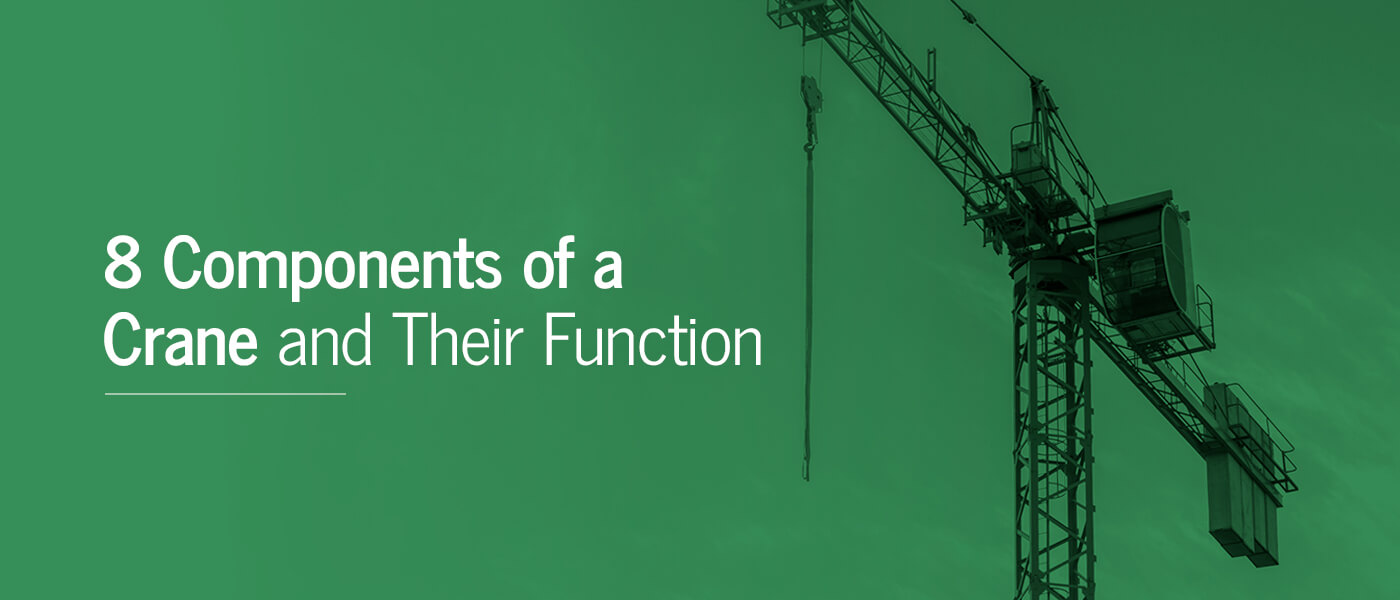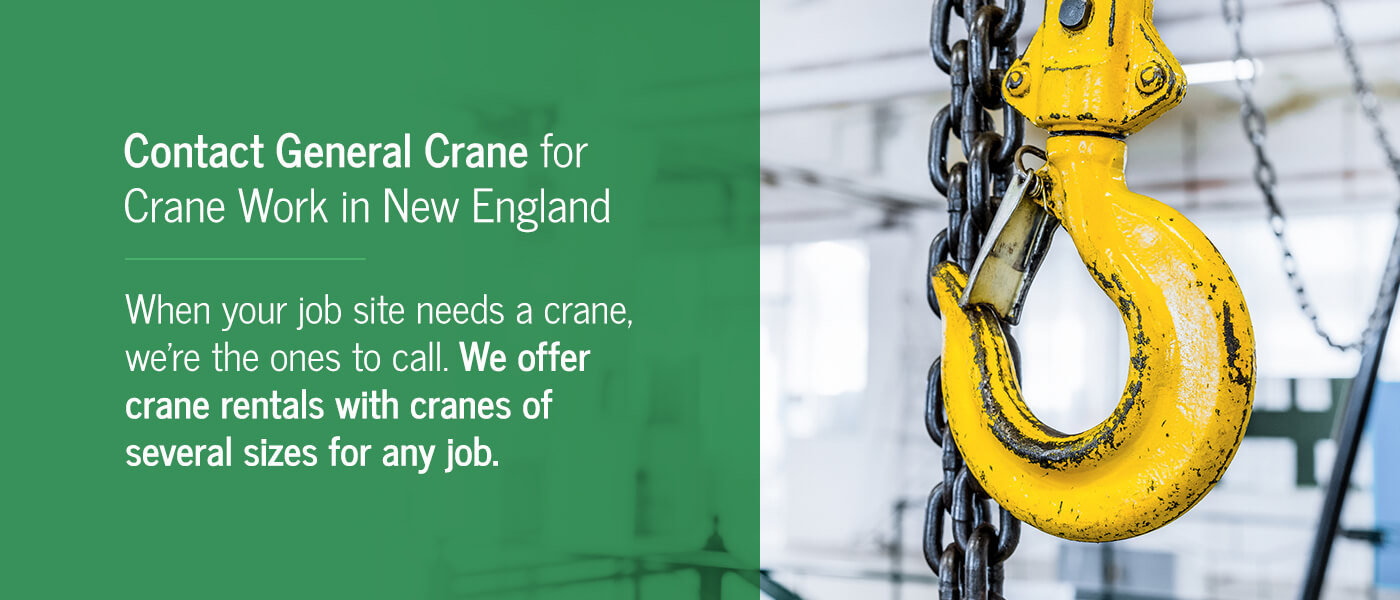Parts of a Crane
Cranes are essential pieces of equipment on construction sites around the world. They make various steps of the building process possible, from reaching the heights of urban skyscrapers to installing trusses on the roofs of rural barns. With cranes, construction crews can work with materials that would be impossible to lift by hand.
Different parts of a crane come together to create the large piece of equipment you recognize from miles away. If you work with cranes on your job site, then it’s important for you to understand the parts of a crane and their functions so you can use your cranes to their fullest potential.
VIEW OUR CRANE SERVICE CAPABILITIES
Crane Parts and Functions
Cranes are a wonder of engineering, and every part is essential for its functioning. Here are eight of the most important crane components you should know about.
1. The Hook
This may be one of the most recognizable and important parts of a construction crane. The hook is the main connecting point between the crane and the load it needs to carry. When you need to move large or heavy items around your job site, you can trust the hook to hold them so the rest of the crane can do its work.
Hooks should be durable and strong so they can handle substantial loads of materials. But hooks rely on other items to pick up a load. The next items on this list play a crucial role in the crane’s ability to lift objects with the hook.
2. Wire Rope and Sheaves
Cranes use heavy-duty wire ropes to lift extreme loads. These ropes are actually cables made of steel wires twisted into the shape of a helix. Then several of these helixes are twisted together to create an even stronger rope. These wire ropes give the crane its strength to lift objects with the hook.
Sheaves are crane components that can increase the weight the hook can lift. A sheave is a pulley system that holds wire ropes that connect to the rest of the crane. The more wire ropes, the more weight is distributed. This allows the hook to lift heavier loads than a single wire rope would be able to lift.
3. The Boom
The boom is one of the largest crane parts, often visible from several miles away depending on the size of the crane. Acting as the arm that holds the load, the boom allows a crane to move heavy items around and send materials far from where the base of the boom is.
There are two types of booms:
- Lattice boom: This boom consists of welded steel, reminiscent of the appearance of a lattice. This gives it great strength while reducing the weight of the boom.
- Hydraulic boom: This boom has telescoping sections, allowing it to extend to reach far places and collapse for easy transportation.
4. Counterweights
Cranes hold a huge amount of weight. They’re able to do this without tipping over by using counterweights. These weights go on the back of the crane and offset the weight of the load. Without counterweights, cranes would tip over in the direction of the boom lift. Counterweights always stay opposite the boom lift to keep the crane grounded and secure.
Counterweights are removable to make transportation easier. You can add or subtract the number of weights in the counterweight system to meet the needs of your current load. Some counterweight systems are towable for even more freedom.
5. Outriggers
Outriggers are crane parts that provide extra safety when moving materials around the job site. Along with counterweights, they ensure that cranes stay standing even when transporting the heaviest of loads. Outriggers extend from the bottom of the crane and stabilize it from the ground. They lift the crane off its wheels, removing the possibility of the crane shifting its position from slight wheel movements.
The combination of outriggers, counterweights and a complex hoist system helps keep your crane secure as it moves heavy loads and materials around the job site. When it comes to operating cranes, safety is key for your entire crew. Outriggers add the extra layer of safety you and your workers need.
6. Wheels and Tracks
Wheels and tracks allow cranes to move around the job site, depending on the terrain. Wheels offer increased mobility, from maneuvering around a job site to driving down the highway at high speeds. They’re the best option for bumpy, uneven ground, but tracks might be your best option if the job site is soft and muddy.
Tracks are long and wide, giving a crane an increased level of stability over wheeled cranes. They’re a bit slower than wheeled cranes and need smooth, even ground for easy operation. But their safety and stability make them an attractive option for many job site managers and engineers.
7. The Hoist
The crane’s hoist, or hoist drum, is the part of the crane that creates lift. It uses a cranking mechanism and a wire rope to raise and lower the hook. It can hold thousands of feet of wire rope, allowing you to move heavy materials over great distances and heights with enough cable left over to maintain a safe hold.
The hoist is what makes it possible for the crane to lift items off the ground. Like the other items on this list, it’s an essential part of the crane and is crucial for it to work. You can find the hoist drum behind the main boom.
8. The Jib
Sometimes cranes need to move materials to an area beyond the reach of the boom. That’s where the jib comes in. This part of the crane is an arm that extends horizontally, providing extra space between the load and the crane. This is useful when you need to move larger or longer loads that require the crane to be farther away during movement.
A regular jib is usually fixed, but a “luffer jib” is a hinged variety found on some cranes. You can move it up or down using its hinges, depending on the location of the main boom at the time of movement.
Contact General Crane for Crane Work in New England
General Crane has been serving areas in New England since our founding in 1972. Since our early days when we only had a single crane to our name, we’ve grown to provide dependable service across construction industries. When your job site needs a crane, we’re the ones to call. We offer novel solutions and provide crane rentals with cranes of several sizes for any job. We even offer boom trucks when you need extra maneuverability on your job site.
Call us today at 860-528-8252 or contact us online for more information. We look forward to serving you on your next New England job site.
Looking to buy a crane instead? Check out our guide on BUYING A CRANE VS. HIRING A CRANE.







